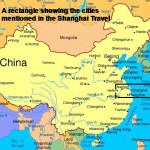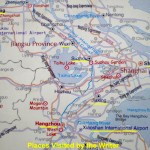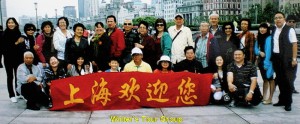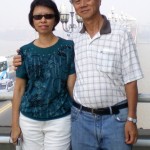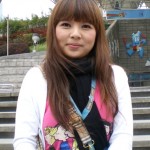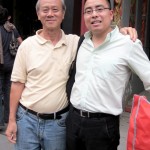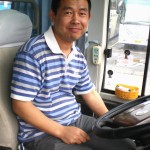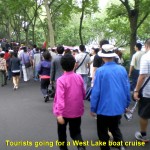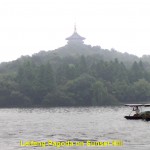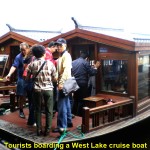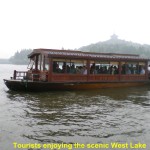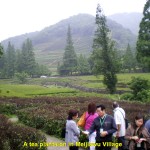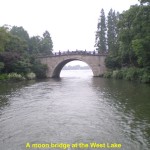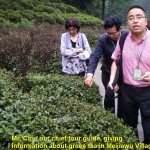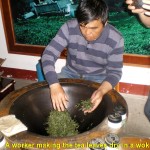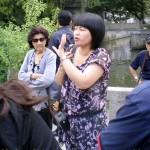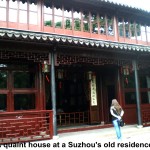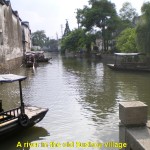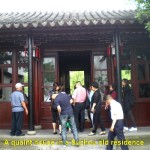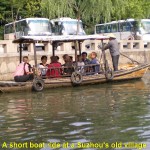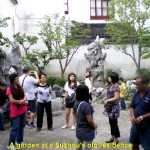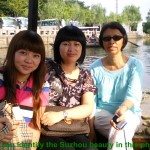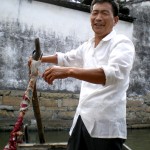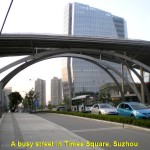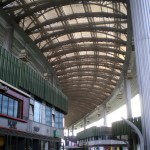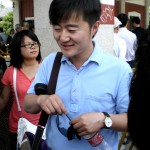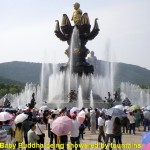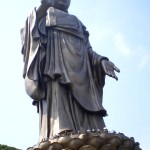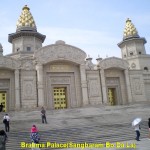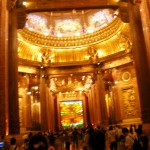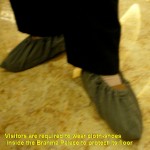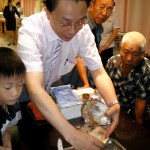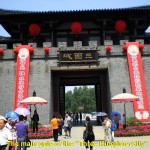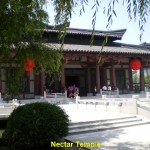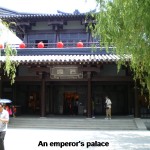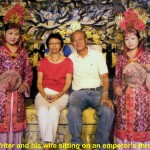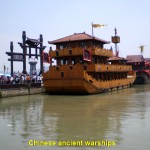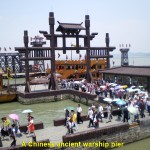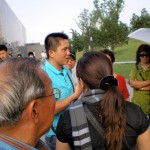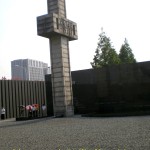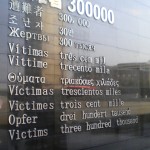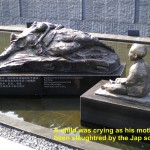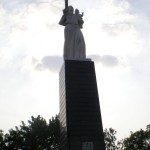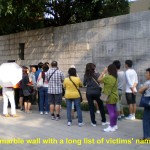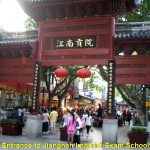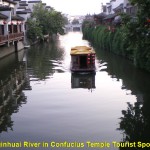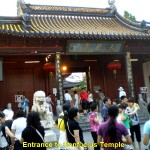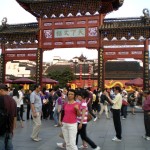Shanghai Travel I
Shanghai Travel I
(Please click on the images below to view large complete ones)
My wife and I have been to the north-east and south-east China. So, in March 2010, we planned to visit a few
tourist destinations in the middle of the eastern coast of China, viz. Hangzhou, Suzhou, Wuxi, Nanjing, Xiaxing and Shanghai. Then we called up our favourite tour agency, Chiu Travel Sdn. Bhd. in Batu Bahat, Johor, Malaysia and booked an 8-day package tour. The tour would be from 3 to 11 June 2010. Below is the dairy of our memorable visit to the historical, cultural and developed cities and their scenic landscape sites.
Travel to Hangzhou
Day 1 3 June 2010 (Thursday)
My wife and I joined a group of 22 people for the tour(see photo above). We were all brought by the tour agency’s bus to KLIA in Sepang from Johor- a 3-hour journey. The agency sent a young, pretty and sweet lady, Miss Ng, to be our tour group leader taking care of us all. On arrival at the airport, we went through the normal procedures: checking-in, security checking, immigration passport stamping and waiting to board the airplane.
At 5.20 in the evening, we left the Malaysian airport by an Air Asia plane. Five hours later, we landed safely at the Hangzhou Xiaoshan International Airport in China where we were greeted by a young prosperous-looking guy, Mr. Chu, who would be with us for the entire 8-day China tour. He would take care of our meals and hotel accommodation, besides conducting the guided tour.
After introducing himself as our chief tour guide, Mr. Chu brought us outside the airport to board a China tour bus. The bus-driver was Mr. Su who was friendly, but a man of few words. He had 17 years of driving experience. Then Mr. Su brought us to a
restaurant in Hangzhou City of 6.7 million people to have a very late dinner before we checked in at a comfortable hotel nearby. It had an unusual name: Day Joy Refinement Hotel.
Day 2 4 June 2010 (Friday)
The Scenic West Lake, Hangzhou
At 9 in the morning, we left the hotel to begin our China tour. Our first visit was the West Lake in the Hangzhou City. When we arrived there, we were amazed to see lots of tourists walking to a pier to board cruise boats. The boats would take them across the lake for sightseeing.
Arriving at the pier, we boarded an electric-powered wooden boat and crossed the scenic West Lake, slowly. As it was moving, we could see three islets in the middle, Hangzhou City in the east and mountainous areas in the north, west and south. Besides, we saw three small stone pagodas of 2 m high standing in the water near the largest islet. They were made in 1621. During the full moon, a candle is placed in a hole in each of the pagodas and its light will mingle with the moonlight in the water. Thus, they are known as “Three Pools Mirroring the Moon”.
Meijiawu Village
After the 30-minute relaxing boat-ride, we left for a famous green tea plantation in Meijiawu Village in a hilly area west of Hangzhou City. This village has a history of 600 years of green tea-making. It produces four types of tea, but the most popular one is known as “West Lake Dragon Well” green tea. It has a strong, pleasant smell and refreshing taste.
Many foreign dignitaries have visited this well-known tea village, like Queen Elizabeth II, the Princess of Thailand and the former President of Soviet Union, Voroshilov. Besides, it has attracted the leaders of China, such as the former Chinese Premier, Zhou En Lai, and former Chinese President, Jiang Zemin.
We spent an hour at a green tea shop in Meijiawu Village learning about tea-making, the benefits of drinking tea, tasting the tea and admiring the scenery of the hills covered with tea plants. Later, we headed for Suzhou City.
Classical Gardens(Residences)in Suzhou Water Town
Suzhou City is about 90 km west of Shanghai. Near this city is a water town. It has canals and arch bridges, like Venice in Italy, and some classical gardens(residences) with many quaint houses along the canals. The latter have historical, cultural, architectural and landscape significance. Only the elite could afford to buy and stay at these gardens in the olden days.
When we arrived there we met aa experienced Suzhou tour guide, Madam Chien. She brought us to see one of the gardens(residences) known as “The Garden of Couple’s Retreat”.
“The Garden of Couple’s Retreat”
Located on the north-eastern edge of the ancient Suzhou City, the Garden of Couple’s Retreat occupies an area of 0.8 hectare. It is surrounded by a tall wall with an entrance in front and a backdoor which leads to a platform by a canal. There are some buildings in the garden which look quaint, elegant and unique in architecture. They are all linked to each other by corridors. In a small area of the garden there is a rock garden mountain and a small summer house by a small pond nearby.
The garden was built in the early Qing dynasty as a pleasure garden of Baoning Prefect, Lu Jing Zhi. Then in 1874 A.D. a governor, Shen Bing Cheng, lived there with his wife when he retired. He named the garden as “The Garden of Couple’s Retreat”. In 1941, a Changzhou industrialist, Liu Guojun, acquired it and spent several years renovating it. In 1955, he donated the garden to the Suzhou Municipal government. Later, the government renovated and opened it to the public to learn about the life-style of the elite in the olden days.
After a tour of the garden, we left by the backdoor and boarded a small boat for a short ride. As an elderly man was rowing the boat down a canal he sang us an old Suzhou love song with much feelings. Soon, we left the place and went to another place known as Times Square.
Suzhou Times Square
Located in the east of the Jinji Lake, Times Square is a large commercial complex which will become Suzhou’s central business district(CBD) soon. When we were at that place we saw the world’s longest LED screen known as West Harmony Sky Screen. It is 500 metres long and 32 metres wide; 100 metres longer than the one in Las Vegas(USA). Unfortunately, after dinner at a restaurant there, we had to leave the place before 7 p.m. So, we felt disappointed for not being able to watch the LED screen at night. Arriving at the Suzhou downtown, we stayed at a hotel known as Lidu Hotel in Suzhou City.
Day 3 5 June 2010 ( Saturday)
Kaidi Silk Factory, Suzhou
As Suzhou has been famous for silk since hundreds of years ago, our tour guide, Madam Chien, brought us to a well-known silk factory, Kaidi Silk Factory, in the morning. When we entered the factory we were surprised to see a lot of tourists. In the factory, we watched machines unwinding silk thread from oval-shaped, white cocoons, workers stretching cocoons into flat pieces and other workers making quilts from those pieces.
After watching those interesting activities, we were led to a room where silk products were on sale. We noticed that the factory was doing a brisk business as many tourists were buying its silk products, such as quilts, silk pillows and silk clothes; thanks to their tour guides who were helping the factory to push its sales. We, too, were convinced by our tour guide, Madam Chien, to buy them. Later, we watched a short fashion show in another room. In the show, pretty Chinese models showed off the factory’s silk dresses as they were walking down a catwalk.
Lingshan Buddhist Scenic Spot , Wuxi
Before we left for another city, Wuxi, we thanked Madam Chien and bade her farewell. When we arrived at Wuxi City, we were greeted by another tour guide, Mr. Chiang, a young handsome guy who had 8 years of experience working as a guide. He brought us to see the World’s tallest standing Grand Buddha statue located on a small mountain, Lingshan, which is 10 km south-west of Wuxi City and near the shore of Taihu Lake(the 3rd. largest freshwater lake in China). Standing 88 metres high, it is made of bronze.
When we arrived at the Wuxi Lingshan Buddhist Scenic Spot where the statue is, we were astounded to see many beautiful new buildings in different parts of the large area. Fortunately, there were many 14-seater cars around to carry tourists to all the places there. As there were many tourists on that Sunday, they had to queue up for the cars to bring them to the places they wanted.
Our tour group took the cars and headed for the Grand Buddha site. When we reached there we saw a statue that was huge, tall and majestic standing on a small mountain. It is known as Grand Buddha. Some of us climbed up a few hundred steps to reach Him to get a closer look. While we were on the high ground, we saw a breathtaking view of the land below which is flat and stretching a few hundred metres to the shore of the Taihu Lake. After a few photo-shoots there, we went to another spot by cars again to see the Baby Buddha statue on a high pedestal.
Baby Buddha
When we reached there we heard a band playing music, loudly, and saw many tourists crowding around a high pedestal. A few minutes later, the fountains round the pedestal were shooting water into the air and showering a large closed lotus flower-shaped structure atop the pedestal. As the flower was opening, slowly, a golden statue of the Baby Buddha was revealed. It was showered by the fountains, at regular intervals. Thus, the spot is called “Nine Dragon Fountains Bathe Siddhartha Gautama(Lord Buddha)”. When the music ended the baby was in the closed lotus flower again and the crowd dispersed.
Sangharam Bo Da La (Brahma Palace)
After that solemn but symbolic show, we joined a long queue for cars to take us to another place which was Sangharam Bo Da La (Brahma Palace). Brahma Palace is a beautiful building that houses sculptures, ornate carvings, paintings and murals that depict the life of Lord Buddha and the spread of Buddhism in China. On the back wall of the hall is a large piece of colourful glazed work known as Avatamsaka World, which has a figure of Lord Buddha in the centre. As the figure is made of gold it is heavily guarded. In the middle of the hall, there is a dome above with wood carvings depicting the life of Lord Buddha.
Before entering the hall, we were given a pair of cloth-shoes to wear over our own shoes. This was to prevent our shoes damaging the floor of the hall. While we were inside the hall we were awe-stricken by all the things that we saw. After spending an hour appreciating the exhibits and learning about Lord Buddha in the hall, we left the Lingshan Buddhist Scenic Spot and headed back for Wuxi City. After dinner at a restaurant we checked in at a hotel known as Milido Hotel in the city.
Day 4 6 June 2010 (Sunday)
A Pearl Factory in Wuxi
In the morning, our Wuxi tourist guide, Mr. Chiang, asked us to visit a well-known pearl factory. When we were there the kind owner opened a large cultured freshwater oyster and showed us its small pearls inside. He told us that small pearls were ground into powder and mixed with a cream that was used for getting rid of blemishes on our faces and bodies, whereas large pearls were used for making jewellery. Then he invited us to see his products and asked us to buy them if we were interested.
The Three Kingdom City, Wuxi
Having spent an hour at the pearl factory, we moved on to a renowned place, The Three Kingdom City. Located in the south-west of Wuxi City and on the northern lakeside of Taihu Lake, it was built by CCTV in 1993 for the purpose of shooting the TV series known as “The Romance of the Three Kingdoms”. The three kingdoms refer to Wei(220-265), Shu(221-263) and Wu(229-280) which were in constant conflict among themselves. To shoot the TV series, CCTV built many Han Dynasty-style buildings including King Wu Palace and Nectar Temple, Caocao’s Army Camp, 7-star altar, signal fire platform, ancient warships and horse battlefield in a total area of 35 hectares. Subsequently, other TV series and movies based on ancient Chinese histories were shot there. (Han Dynasty ruled from 206 B.C. until 220 A.D.)
Besides being a shooting location for TV series and movies, just like the Universal Studios in Hollywood, The Three Kingdom City site has become a popular tourist attraction.
In The Three Kingdom City, we marvelled at the beauty of the buildings, enjoyed the sights of the landscape and had short ride in an “ancient” Chinese warship in the Taihu Lake. We were fortunate to watch an ancient dancing concert performed by young and energetic performers in a crowded building(“Nectar Temple“). At 12.30 p.m. we left the place and travelled north-west to Nanjing. It took us about three hours to reach there.
Nanjing War Memorial Museum
On arrival at Nanjing City of 6 million people, we headed straight to the War Memorial Museum. At the museum we were greeted by a Nanjing tour guide, Mr. Lee, a serious-looking gentleman. As we were walking in the War Memorial compound, we saw sculptures of war victims in various states of sufferings and death. We also saw a 12-metre high cross showing the period of the massacre, carvings on a long high wall depicting the massacre, many memorial stones commemorating the victims killed in different parts of Nanjing, stone covered ground where some victims were believed to have been buried, a black wall with shocking words “Victims: three hundred thousands” written in 10 languages, and a large statue of a Nanjing woman who was a victim.
“The Pit of the 10,000 corpses”
Mr. Lee with a solemn face told us how the 300,000 innocent civilians and unarmed soldiers in Nanjing were slaughtered for six consecutive weeks by the Japanese invaders in 1937 and where the mass graves were. When he brought us inside a building we were shocked to see a lot of human bones lying in an exposed mass graveyard under spotlights. He told us that 9,721 dead bodies were buried there, thus the place is known as “The Pit of the 10,000 corpses”. It was a grim and depressing sight to all of us. Besides, it gave us the shivers when we thought of war atrocities. (This place is not for the faint-hearted as it had affected some of our tour members later.)
“The Peace Park”
Then Mr. Lee led us out of the inferno to an open-air area known as “The Peace Park”. Located at this park is a statue of a woman standing on a high pedestal of over 25 metres. She is releasing a dove in one hand and carrying a child in the other, seemingly, appealing to the whole world to live in peace. Finally, we left the museum with deep sympathy and sadness for the war victims. Some of us might leave the place with an indelible memory of the horrific WWII event in the Nanjing dark history.
Fujimiao(Confucius Temple) and Qinhuai Scenic Spot
After an early dinner, we went to a popular shopping and cultural area known as Fujimiao(Confucius Temple) and Qinhuai Scenic Spot which is along the Qinhuai River in south Nanjing City. This place has been a popular tourist destination for a long time.
Jiangnan Examination Hall
At this place, there are two significant large buildings that have been built in ancient Chinese architectural styles to replace the old ones. They both have cultural and historical significance. They are the Jiangnan Examination Hall and the Confucius Temple. Originally, the former was built in 1168 as a county and prefecture examination centre. Later, when Nanjing became the capital of the Ming Dynasty, it became a centre for province and imperial exams. But, when the capital was moved to Beijing in 1421, it carried out the county exams only. The centre had produced many famous scholars in the olden days. The present building was built in 1989 to replace the old one.
Fujimiao Temple(Confucius Temple)
The Fujiamiao Temple or Confucius Temple was first built in 1034 to commemorate the great thinker and educator, Confucius. Devotees from near and far came to the temple to worship the sage. It had been damaged, set on fire and repaired several times. Then it was rebuilt in 1984 and completed in 1985.
Many old buildings around them had been pulled down to make way for new ones. Most of these are now shops selling goods ranging from food and beverages to clothes and handphones.
Qinhuai River Attraction
Another attraction in this area is the Qinhuai River. It is 110 km long and a branch of the Yangtze River, passing through the city of Nanjing. In the olden days, it was an important means of transport. Tourists now can take a boat cruise along this river to see ancient buildings, old gardens and bridges.
Walking in the Fujimiao tourist area, seemingly, brought us back to the olden days when the place was crowded with people who were visitors, traders, devotees and scholars. We spent an hour or so at the busy place, before we stayed at a hotel known as Jihua Garden Hotel in the downtown.
(continued in Shanghai Travel II)

